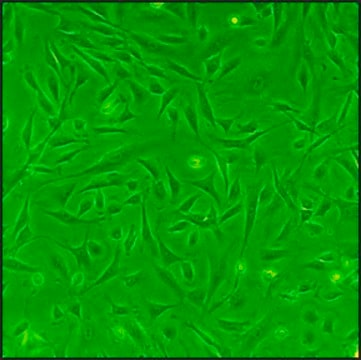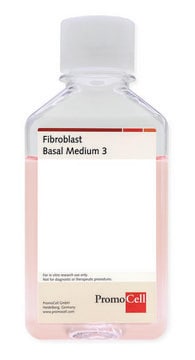R306-05N
Rat Cardiac Fibroblasts: RCF, neonatal
Zaloguj sięWyświetlanie cen organizacyjnych i kontraktowych
About This Item
Kod UNSPSC:
41106514
NACRES:
NA.81
Polecane produkty
pochodzenie biologiczne
rat heart (Sprague Dawley, neonatal)
Poziom jakości
opakowanie
pkg of 500,000 cells
producent / nazwa handlowa
Cell Applications, Inc
tryb wzrostu
Adherent
kariotyp
2n = 42
morfologia
fibroblast
metody
cell culture | mammalian: suitable
powiązane choroby
cardiovascular diseases
Warunki transportu
dry ice
temp. przechowywania
−196°C
Opis ogólny
Lot specific orders are not able to be placed through the web. Contact your local sales rep for more details.
Cardiac fibroblasts are the most prevalent cell type in the heart, making up 60-70 % of all cells. They are known to play key roles in the development of cardiac disease and hypertrophy. Rat Cardiac Fibroblasts from Cell Applications, Inc. provide an excellent model system to study many aspects of heart function and pathophysiology, including the regulation of cell growth, survival, inflammation, hormone secretion and metabolism.
Cardiac fibroblasts are the most prevalent cell type in the heart, making up 60-70 % of all cells. They are known to play key roles in the development of cardiac disease and hypertrophy. Rat Cardiac Fibroblasts from Cell Applications, Inc. provide an excellent model system to study many aspects of heart function and pathophysiology, including the regulation of cell growth, survival, inflammation, hormone secretion and metabolism.
Pochodzenie linii komórkowej
Heart
Zastosowanie
human heart function, neointimal formation, vascular remodeling, myocardial repair, extracellular maintenance, signaling, toxicology, gene expression, structural support for cardiomycytes, synthesis of extracellular matrix, growth factors and cytokines
Komponenty
Fibroblast Basal Medium that contains 10% FBS and 10% DMSO
Uwaga dotycząca przygotowania
- 2nd passage, >500,000 cells in Rat Fibroblast Basal Medium that contains 10% FBS and 10% DMSO
- Can be cultured at least 8 population doublings
Rutyna subkultury
Please refer to the RCF Culture Protocol.
This page may contain text that has been machine translated.
Kod klasy składowania
11 - Combustible Solids
Klasa zagrożenia wodnego (WGK)
WGK 3
Temperatura zapłonu (°F)
Not applicable
Temperatura zapłonu (°C)
Not applicable
Certyfikaty analizy (CoA)
Poszukaj Certyfikaty analizy (CoA), wpisując numer partii/serii produktów. Numery serii i partii można znaleźć na etykiecie produktu po słowach „seria” lub „partia”.
Masz już ten produkt?
Dokumenty związane z niedawno zakupionymi produktami zostały zamieszczone w Bibliotece dokumentów.
Nasz zespół naukowców ma doświadczenie we wszystkich obszarach badań, w tym w naukach przyrodniczych, materiałoznawstwie, syntezie chemicznej, chromatografii, analityce i wielu innych dziedzinach.
Skontaktuj się z zespołem ds. pomocy technicznej





